Figure 4.

p53-GAPDH interaction involves in GluR2 AMPA receptor mediated cell death. A, Bar graph and representative figures summarizing the glutamate-induced cell death data in the presence/absence of p53 antagonist cyclic PFT-α (10 μM, 1 hr) in HEK-293 T cells expressing GluR1/2 subunits through quantitative measurements of PI fluorescence. *Significantly different from control group (p < 0.05; n = 9 per group); t-test. B, Bar graph summarizing the glutamate-induced cell death data in the presence/absence of p53 antagonist cyclic PFT-α in HEK-293 T cells expressing GluR1/3 subunits through quantitative measurements of PI fluorescence (n = 9 per group). C, Bar graph summarizing the glutamate-induced cell death data obtained from HEK-293 T cells co-expressing GluR1/2 subunits with/without the TAT-GAPDH2–2–1–1 peptide. **Significantly different from non-treatment/transfection group (p < 0.01; n = 9 per group); D. Western blots analysis of GAPDH expression in the nucleus with/without glutamate treatment in the presence/absence of TAT-GAPDH2–2–1–1 peptide in HEK-293 T cells expressing GluR1/2 subunits. LaminB1 was used as the nuclear marker. E, Western blots analysis of nuclear p53 and p53 phosphorylation at serine46 in HEK-293 T cells co-expressing GluR1/2 subunits with the GAPDH2–2–1–1 mini-gene upon glutamate stimulation. (t-test, *p < 0.05, n = 3).
